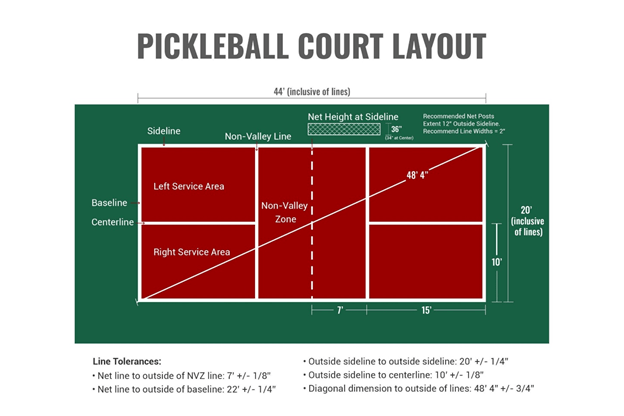Professional Pickleball Court Construction-- From Layout to Installation
Professional Pickleball Court Construction-- From Layout to Installation
Blog Article
Sustainable Practices in Pickleball Court Construction You Ought To Know
As the appeal of pickleball continues to climb, so also does the demand for lasting techniques in court building. This method not only addresses environmental concerns yet likewise enhances the long life and capability of the courts. From choosing green materials to executing efficient water drainage and energy-saving lights remedies, there are many techniques to consider. The influence of these practices extends much beyond the court itself. Understanding how each aspect contributes to a much more lasting future invites better expedition right into the complex equilibrium between recreational growth and ecological stewardship.
Selecting Eco-Friendly Products
Picking green materials is a critical action in the building and construction of sustainable pickleball courts. The option of lasting materials not just reduces environmental effect however likewise improves the durability and performance of the court. Secret materials include recycled rubber for the surface, which supplies outstanding toughness and shock absorption while diverting waste from landfills.
Additionally, making use of locally sourced products reduces transport emissions and sustains local economies. Pickleball court construction. For instance, utilizing native hardwoods for fence and seating can supply a sustainable aesthetic while guaranteeing resilience versus the aspects.
Incorporating permeable products for court structures can even more add to sustainability by enabling all-natural water drainage and lowering runoff. These selections not just safeguard neighborhood communities however additionally advertise much healthier play atmospheres.
Efficient Water Drainage Solutions
While the option of environmentally friendly materials is vital, carrying out efficient drainage solutions is equally critical for keeping lasting pickleball courts. Appropriate drain not just protects the court surface from water damage yet also lessens erosion and runoff, promoting ecological honesty.
Effective drainage systems can consist of permeable paving, which permits water to penetrate the ground instead of merging on the surface. This minimizes the chance of standing water, which can cause mold and other upkeep issues. Furthermore, integrating purposefully positioned drainage channels and swales can route excess water far from the court area, making sure a completely dry having fun surface and stopping soil erosion.
Making use of indigenous vegetation in the landscaping around the courts can further enhance water drainage by soaking up excess water and minimizing runoff. These plants need much less irrigation and advertise biodiversity, lining up with sustainable techniques.
In addition, it is important to on a regular basis maintain the drain system to guarantee its long-lasting effectiveness. This consists of clearing particles and tracking for clogs. By prioritizing reliable drain solutions, pickleball court producers can considerably add to the sustainability and durability of the facility, eventually profiting both players and the setting.
Energy-Efficient Lighting Options
As the demand for pickleball proceeds to expand, integrating energy-efficient lights choices right into court style has actually come to be increasingly crucial for sustainability. Traditional illumination systems often consume excessive energy, adding to higher functional expenses and ecological effect. Consequently, taking on contemporary, energy-efficient technologies is necessary for both brand-new building and constructions and remodellings.
LED (Light Emitting Diode) lighting stands apart as a leading option because of its longevity and power financial savings (Pickleball court construction). Contrasted to traditional illumination, LEDs use about 75% much less energy and can last up to 25 times longer, considerably decreasing upkeep prices. Moreover, the directional nature of LED lighting minimizes light pollution, guaranteeing that illumination is concentrated on the court as opposed to surrounding locations.

Lasting Surface Alternatives
Discovering sustainable surface choices for pickleball courts has actually obtained grip among players and home builders alike. The focus on environmentally friendly products not just straightens with the growing environmental recognition yet additionally improves the performance and durability of the courts.
One prominent option is using recycled rubber, which can be sourced from made use of tires. This material gives outstanding shock absorption, decreasing the threat of injuries for gamers while promoting sustainability. Additionally, modular tiles made from recycled plastics offer an additional practical alternative. These tiles are simple to set up and change, and their flexibility enables numerous court arrangements.
Natural lawn courts are additionally emerging as a sustainable selection, advertising biodiversity and lowering the warmth island result. They require regular maintenance and water, which may not straighten with all sustainability goals.

Water Conservation Strategies

Another reliable method involves the installment of rainwater harvesting systems. These systems save and gather rain for use in preserving court surfaces and landscape design. This strategy not just saves drinkable water but additionally decreases reliance on community resources.
Furthermore, utilizing drought-resistant landscape design around the courts is important. Indigenous plants need much less water and are much better adjusted to local climate conditions, hence decreasing general water usage. In addition, utilizing efficient irrigation systems, such as drip irrigation, makes sure that water is supplied straight address to plant origins, minimizing evaporation and waste.
Final Thought
Including sustainable techniques in pickleball court construction substantially adds to environmental conservation and resource effectiveness. By prioritizing these methods, the construction of pickleball courts can line up with more comprehensive ecological goals while promoting long life and capability within neighborhoods.
As the appeal of pickleball continues to increase, so also does the need for sustainable methods in court building and construction.Choosing environment-friendly materials is a vital action in the construction of sustainable pickleball courts. By prioritizing energy-efficient lights alternatives, pickleball court constructors can add to an extra sustainable future while satisfying the requirements of stakeholders and gamers alike.Integrating sustainable surface options not only improves the performance of pickleball courts however likewise leads the way for carrying out reliable water conservation strategies.Including lasting methods in pickleball court construction substantially contributes to environmental conservation and resource performance.
Report this page